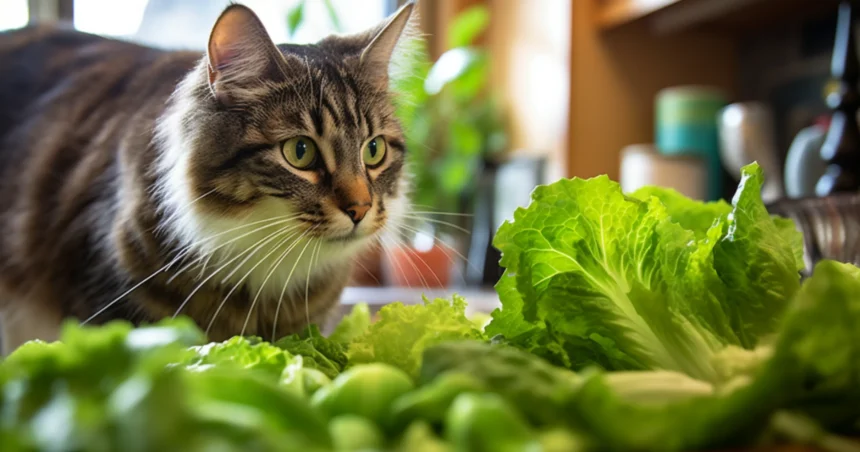As cat parents, we all want the best for our furry friends. Part of caring for cats is feeding them an appropriate diet. Cats are obligate carnivores, meaning they need meat-based proteins. But what about veggies like lettuce? Can cats eat lettuce safely? While lettuce won’t harm them, it has limited nutritional value for cats. In this article, we’ll explore whether lettuce should be part of your cat’s diet. We’ll discuss the potential benefits and downsides of lettuce for cats. We’ll also provide tips for how to feed lettuce to cats, if you choose to offer it occasionally as a low-calorie snack.
Can Cats Eat Lettuce?
Good news for all the salad-sharing cat parents out there: the answer is yes! Cats can indeed have a nibble of lettuce. However, like many things in life, moderation is key. While lettuce isn’t toxic or harmful for our feline friends, it’s also not their go-to meal.
You see, cats are primarily meat-eaters. Their dietary needs revolve around proteins found in meat. Lettuce doesn’t quite fit the bill as a primary food source. Think of it as an occasional treat or a light snack. So, while it’s okay to share a leaf or two, always remember: lettuce is a side dish, not the main course, in the world of cats.
The Benefits of Lettuce for Cats
Alright, so we’ve established that cats can eat lettuce. But the next logical question is, why would they even want to? Let’s delve into some of the benefits this green leafy vegetable can offer our feline friends.
1. Hydration Boost: If you’ve ever crunched into a fresh piece of lettuce, you’d know it’s pretty watery. In fact, lettuce is made up of about 90% water. For cats, especially those who aren’t big drinkers, munching on lettuce can provide an additional source of hydration.
2. Fiber-Rich: Believe it or not, lettuce is a good source of fiber. While cats don’t need as much fiber as humans, it can help in promoting a healthy digestive system. So, if your cat’s been having some tummy troubles, a little lettuce might just help things move along.
3. Vitamins and Minerals: Lettuce isn’t just water and fiber. It’s packed with essential vitamins and minerals like vitamin A, vitamin K, and folate. While these aren’t a cat’s primary dietary requirements, they’re still beneficial in small amounts.
4. Weight Management: For those cats that might be carrying a few extra ounces (or pounds), lettuce can be a calorie-controlled treat. It’s low in calories but can still satisfy their urge to chew on something.
In moderation, lettuce is a hydrating, fiber-filled snack for cats. But it should not replace more nutritious cat foods designed to meet feline dietary needs. Think of lettuce as just an occasional treat!
The Limitations of Lettuce for Cats
Now that we’ve discussed some potential benefits, it’s important to note the limitations of lettuce for cats:
1. Limited Nutritional Value: Even for us humans, while lettuce is refreshing and can be a hydrating snack, its nutritional value is somewhat limited. It’s not bursting with the nutrients we might find in other veggies or greens.
2. Cats are Obligate Carnivores: This is a fancy way of saying that cats need meat. Their bodies are designed to derive essential nutrients from animal-based proteins. In the wild, a cat isn’t hunting down lettuce; it’s after prey. The amino acids, vitamins, and minerals found in meat are critical for their health.
3. Missing Proteins: Lettuce simply doesn’t provide the proteins cats need. While it offers hydration, fiber, and some vitamins, it’s missing the essential proteins that are the cornerstone of a cat’s diet.
While small amounts of lettuce are safe for cats, it does not provide much real nutritional value. Lettuce lacks the vital proteins and amino acids obligate carnivores like cats need. It should never replace high-quality cat food that is animal-based and nutritionally balanced. Lettuce is ok as an occasional snack, but not as a dietary staple.
How to Feed Lettuce to Cats
Now that we’ve covered the pros and cons, here are some tips for safely incorporating lettuce into your cat’s diet:
1. Not a Meal Replacement: First and foremost, lettuce should never replace a cat’s balanced diet. Cats need their regular meals to ensure they get the necessary nutrients, primarily animal proteins. Think of lettuce as a garnish or an occasional bonus, not the main dish.
2. Treat or Topper: A little sprinkle of shredded lettuce on top of their food can be a fun change for your kitty. It adds texture and variety without detracting from the main nutritional content.
3. Choose the Right Lettuce: Not all lettuces are created equal. Romaine, butterhead, and leaf lettuce are generally safe bets. They’re softer and easier for cats to digest.
4. Avoid Iceberg and Onions: While iceberg lettuce isn’t toxic to cats, it’s tougher and offers even less nutritional value than other types. And a heads-up: never pair lettuce with onions. Onions are toxic to cats and can lead to serious health issues.
In essence, introducing lettuce to your cat’s diet can be a fun and hydrating treat. Just make sure to serve it up the right way and keep those key precautions in mind!
Conclusion
To sum it all up, cats can eat lettuce in moderation but it should not make up a significant portion of their diet. A few pieces of lettuce here and there is fine, but don’t rely on it as a major food source. Lettuce can add some hydration, fiber, and chewing satisfaction, but lacks the protein and nutrients obligate carnivores require.
Be mindful of preparation, portion size, and freshness when feeding lettuce to cats. And of course, a balanced commercial cat food should still be the foundation of your feline friend’s meals. Incorporating small lettuce snacks can add variety, but meat-based cat foods are essential to provide cats with complete nutrition.


